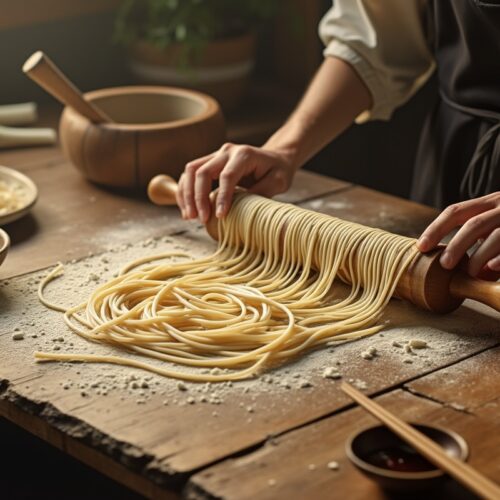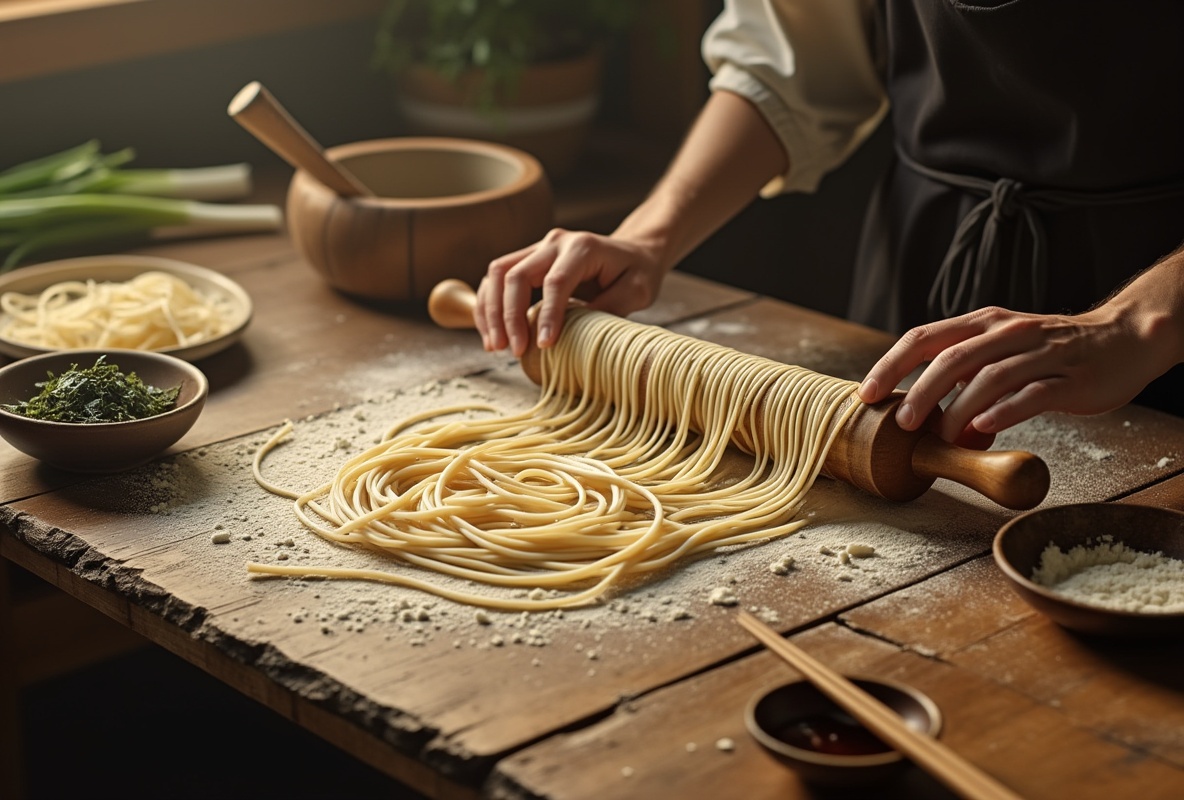Embark on the Ramen Noodles Historical Roots Journey
In the realm of Japanese cuisine, the enchantingly rich Ramen Noodles Historical Roots beckon us to explore. This culinary journey delves into the origins of ramen noodles, tracing back to their vibrant history and evolution from Chinese influences. I love how each steaming bowl reflects a tapestry of traditions and flavors, emphasizing why ramen remains a beloved staple. Join me as we uncover the story behind this iconic dish and savor its timeless appeal. Learn more about the fascinating origin of ramen noodles and its influence on global cuisine.
Recipe Highlights: A Nod to Ramen’s Past
Explore the traditional ramen noodle history through this delightful recipe, which captures the essence of Japanese noodle history. Here’s what makes it special:
- Prep Time: Get everything ready in just 15 minutes.
- Cook Time: Savor the rich flavors developed in a 30-minute cook.
- Servings: Perfectly designed to serve a cozy group of 4.
- Special Features: Enjoy traditional flavors that are easy to customize for any palate.
Because of its authentic essence and ease of preparation, this recipe is a wonderful way to connect with ramen’s origins while experimenting with flavors that suit your tastes. Looking for inspiration? Check out the best meat choices for ramen to add a perfect protein twist to your dish.
Essential Ingredients for Authentic Ramen
Discovering the origins of ramen noodles leads us to embrace traditional ramen noodle history itself through the ingredients. Each component plays a crucial role in recreating the authentic Japanese noodle experience. Here’s what you’ll need:
- Wheat-based noodles: The heart of ramen; choose fresh or dried, based on preference.
- Pork or chicken broth: Slowly simmered for a rich and savory base.
- Shoyu or miso paste: Adds depth and umami to the broth.
- Thinly sliced pork belly: Offers a tender and flavorful protein element.
- Assorted vegetables: Such as bean sprouts and bamboo shoots for texture and nutrition.
Optional Toppings:
- Soft-boiled eggs: A creamy and delicious addition.
- Green onions: For a fresh and mild onion flavor.
- Nori seaweed: Provides a touch of oceanic taste.
These ingredients capture the essence of Japanese noodle history and invite you to explore the delectable journey through time and flavor. For a modern twist on traditions, explore the story behind the innovative ramen burger and how it bridges culture and creativity.
Instructions for Making Traditional Ramen
- Prepare the broth: Simmer your chosen protein, such as pork belly or chicken, with traditional seasonings, like shoyu or miso paste. For those interested in learning more about exceptional broth combinations, consider exploring tips for selecting the best meat options for ramen.
- Cook the noodles: Bring water to a boil and cook the wheat-based noodles until they are al dente. Drain and set aside.
- Slice and set toppings: Thinly slice the cooked pork belly and prepare assorted vegetables, such as bean sprouts and bamboo shoots.
- Simmer additional toppings: Add thinly sliced pork belly, assorted vegetables, and optional items like soft-boiled eggs to the simmering broth for enhanced flavor.
- Assemble the bowl: Place cooked noodles into individual bowls. Pour the hot broth over them, ensuring equal distribution of the pork and vegetables.
- Add garnishes: Top each bowl with green onions and nori seaweed. Consider adding chili oil for a spicy miso variation.
- Serve immediately: Present the ramen with perfect sides like gyoza dumplings or pickled vegetables to complement the rich flavors.
Tips and Creative Variations for Ramen Noodles Historical Roots
Make your ramen experience unique with these suggestions:
- Use fresh ingredients: Ensure the best taste by sourcing fresh vegetables and proteins.
- Simmer slowly: For a rich, flavorful broth, simmer your ingredients steadily over low heat.
- Add spice: Try a spicy miso version by incorporating a dash of chili oil.
- Go gluten-free: Substitute traditional noodles with gluten-free alternatives for dietary needs.
- Experiment with toppings: For example, add kimchi for a tangy twist or extra nori for umami richness.
- Infuse flavors: In addition to the staple miso, infuse the broth with ginger and garlic for deeper complexity.
Explore these tips and variations to elevate your ramen, diving deeper into its origins by checking out the history of ramen noodles while personalizing each bowl.
Enhance Your Ramen Experience with Perfect Pairings
Elevate your enjoyment of traditional ramen noodle history with these thoughtful serving ideas:
- Teaming with Sides: Pair your ramen with gyoza dumplings for a classic duo.
- Taste of Umami: Opt for pickled vegetables; they complement the rich broth beautifully.
- Refreshing Drinks: Savor your bowl alongside chilled sake for an authentic touch.
- Gentle Accents: Pour a cup of green tea for a soothing finish.
- Extra Texture: Include crispy spring rolls or shrimp tempura for a delightful crunch.
Frequently Asked Questions About Ramen Noodles Historical Roots
What is the history of ramen noodles in Japan?
Ramen noodles trace their origins back to Chinese influences. Over centuries, they evolved into a beloved staple in Japanese cuisine. Learn more about the origin of ramen noodles history.
Can I prepare the broth in advance?
Yes, you can refrigerate the broth for up to three days or freeze it for longer storage.
What makes a ramen noodle authentic?
Authentic ramen noodles are made with wheat-based noodles, a rich broth, and traditional toppings like pork belly and nori.
How has ramen evolved over time?
Ramen has transformed through regional variations across Japan, adapting unique flavors and ingredients.
Is it possible to customize ramen toppings?
Absolutely, ramen is highly customizable. Common additions include soft-boiled eggs, green onions, and bean sprouts.
Bringing It All Together
Explore and savor the Ramen Noodles Historical Roots with our authentic recipe. Here’s how to make the most of your ramen journey:
- Experiment Boldly: Swap in seasonal vegetables for a fresh twist.
- Showcase Your Creations: Share photos of your ramen on social media. Tag us for a chance to be featured.
- Complete the Meal: Pair with gyoza dumplings and chilled sake for an elevated experience.
As you embark on this culinary adventure, remember, the history is as rich as the flavors. Dive in, get creative, and enjoy every bite. Happy cooking, and we can’t wait to see your masterpieces!

Classic Ramen Noodles
Equipment
- Medium pot
- Medium saucepan
- Ladle
- Knife
- Chopping board
- Tongs
Ingredients
- 4 cups chicken broth low sodium
- 2 tbsp soy sauce
- 1 tsp sesame oil
- 2 packs instant ramen noodles without seasoning packets
- 1 large egg soft-boiled
- 2 cloves garlic minced
- 1 tsp grated ginger fresh
- 1 cup shiitake mushrooms sliced
- 1 cup fresh spinach washed
- 1 green onion sliced for garnish
- 1 sheet nori cut into strips for garnish
Instructions
- In a medium pot, heat sesame oil over medium heat. Add minced garlic and grated ginger, sauté for 1-2 minutes until fragrant.
- Pour in chicken broth and soy sauce. Bring to a boil, then reduce the heat and let it simmer for 10 minutes.
- In a separate saucepan, cook the instant ramen noodles according to the package instructions. Drain and set aside.
- Add sliced shiitake mushrooms to the simmering broth. Cook for 5 more minutes until tender.
- To serve, divide the cooked noodles evenly between two bowls. Ladle the hot broth over the noodles.
- Top each bowl with a soft-boiled egg, fresh spinach, sliced green onion, and nori strips. Serve immediately and enjoy.

